


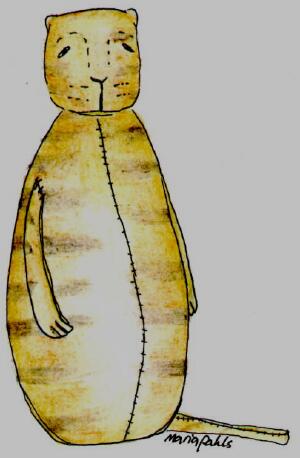
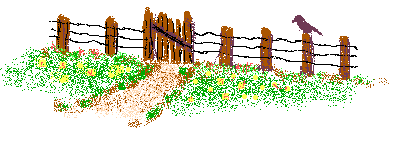
the fence post
(editor's letter)
dear friends:
with the bombardment of so many types of collectibles today its a wonder that anyone can decide what to begin seeking out to begin a collection.
when trying to decide what it is that you will collect you need to consider several factors.
- budget: while you may love steiff bears the truth is they are not always affordable. be sure to select something that is affordable or that you don't mind saving for between acquisitions. this may mean passing up a piece if your budget doesn't allow for multiple purchases.
- love it!: stay away from trends that you see in magazines, collect what you truly love and don't let anyone else dictate what you should collect. what's hot now may not be hot in six months. keeping up with the trends may just give you burn out...if you enjoy bird's nests then collect those.
- display: decide if you want to have a collection that you can display. many collections need special consideration -for example a gun collection needs to be kept safely, an photo collection needs to be kept with archival storage etc....will your collection compliment your decor and if not can you live with that? if you have children or pets you also need to take in the factor of breakage,as well as safety issues such as lead. also consider maintenance. some items need upkeep.
- availability- if you want your collection to come together quickly consider more readily available things such as crocks, kitchen utensils etc. a collection of rare items may only contain 3 pieces. if you are content with only occasionally adding to your collection this would be fine,if you want to buy a piece each month stay with accessible items.
- insurance- have any collection appraised and insured in case of fire or theft. keep photo records and receipts in a safety deposit box as well as contact your home insurance carrier to be sure you have sufficient coverage.
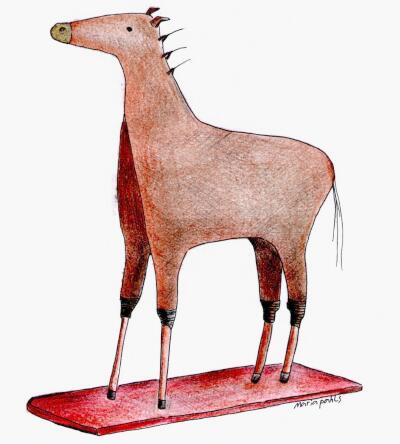
primitively yours,

maria pahls
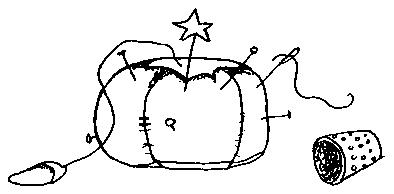
tips & techniques
Batik Fabric by beth nettles edited by maria pahls
Batik is a wonderful technique for creating unique fabrics designs with an aged, primitive/folksy look. This process, which involves the use of wax and dyes, is usually associated with tropical motifs from the Caribbean and South Pacific. It can be used just as easily for primitive designs and faded, muted colors. Batik produces a soft, diffused transition between colors, whereas most factory-printed fabrics have a clearly defined ("hard") separation between areas of different colors. depending on the type of wax used, interesting crackle effects can be achieved with batik.
If you have difficulty finding just what you are looking for in ready-made fabrics try creating a special piece with the batik process. There are many excellent books on the topic. The basic procedure is to use unbleached muslin that has been laundered (without fabric softener) to remove the sizing. Either freehand or lightly pencil in a design to the right side of the fabric. Depending on the design apply melted wax with either a traditional batik tool called a tjanting (pronounced "jonting") or a brush (this will make the brush unusable for anything else but batik). You can also use a stencil, applying the wax to the fabric through the open "cut out" areas of the stencil. Wax over the areas that you want to remain white. When the waxing is complete dye the fabric using Deka Series L dyes or Rit dyes. Begin the first dye bath with the lightest color in the palette (usually yellow). Once fabric is dry, wax over the areas that are to be yellow. Repeat process working to darker grades and changing colors waxing between each dye bath. Bleaching with a mild solution of water and commercial bleach can return the remaining surface area back to a lighter color for adding fine detail. The wax is removed by placing the fabric between newsprint and brown craft paper and ironing until the paper absorbs all the wax. Dry clean the finished piece for maximum wax removal. Depending on the complexity of the design or number of colors, the waxing and dying steps might be repeated a number of times. Batik is not a quick process, but it is well worth the effort when you want a really special fabric design!
batik technique #2: try a negative batik, begin with black cotton fabric. chalk on your design. wax the area you want to remain black. bleach in a very mild solution of warm water & bleach (note take the fabric out of the bleach bath when it is one step darker than you want because it will dry lighter). your fabric will now be orange or dark brown with the black areas waxed. next wax the areas you want brown and repeat making the background lighter and lighter. you can over dye the bleached fabric as well. remove wax as directed.
lead test pick up a lead test kit at your local hardware store use it for furniture and dishes and anything you pick up at sales,shops or flea markets. you certainly don't want to display apples in a lead painted bowl...or allow children to play with lead figurines, or have chipping lead paint get sampled by your pets. even NEW dishes produced in foreign countries may test positive for lead.

WHAT'S IT?
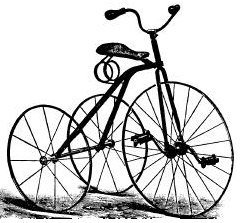
velocipede an early bicycle propelled by pushing with the feet along the ground while straddling the vehicle. any of the early bicycles having pedals attached to the front wheel. a tricycle.*
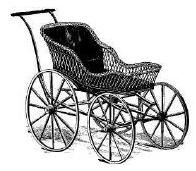
perambulator a baby carriage.
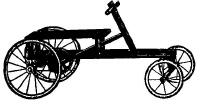
propeller a three or four wheeled car type riding toy that was propelled by working hand controls and controlled by moving a rudder with the feet. similar were the "hand car" (left) and the "irish mail wagon" (right). these were controlled by pumping a handle bar that worked a gear attached to the rear axel.
sulkie~ a small two wheeled vehicle to be drawn by a horse or other animal. often for children a wooden or three dimensional stuffed horse was suspended in front of a propeller cart with the horse having wheels at its front hooves or the horse suspended between the support bars of the front wheel or wheels.
shoofly~ a small rocker,usually with wooden cut out horses on either side of a sunken flat seat. a child would sit inside and move the unit by rocking. similar was the chair rocker in which the seat was elevated at the rear of the rocker and had a spindle back.
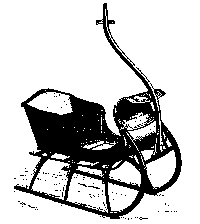
cutter~ a small sleigh, usually seating one person that could be pushed from a handle behind the seat modeled after larger size horse drawn sleds.
clipper~ a small flat type sled with two runners with a flat seat in the center.
noon pieces or lunch pieces~ often the term given to pottery pieces made free form by potters with any remaining clay that was left shortly before the lunch break (since there was not time to create a pre specified piece and in order not to waste moist clay.)
* = source:american heritage dictionary 2nd ed.
ARTICLES OF PRIMITIVE
sunday toys in days gone by children were expected to be seen but not heard on the sabbath. boisterous play was forbidden and a child was expected to occupy himself with what were known as "sunday toys". perhaps due to its biblical ties one popular sunday toy was the noah's ark. generally in the form of a wooden ship with pairs of tiny hand carved animals that a child might arrange over and over in various configurations. another toy was a "garden of eden". wood carved adam and eve figures accompanied by animals and the tree of life. like sunday garments, these toys were special and only brought out on the sabbath. many folk art toys can be attributed to the pennsylvania and new england provinces probably because wood was abundant and whittling was a popular past time of men and boys.
one of the most sought after early 19th century toy makers is wilhelm schimmel, an itinerant carver, he traveled throughout the southeastern pennsylviania area exchanging his carved polychrome animals and toys for a mere meal or a glass of rum.
the beginning of the toy industry in america
the first decades of the nineteenth century brought into being the american toy industry. a carpenter from massachusetts named william s. tower has often been referred to as it's founder. though wood was popular and plentiful for toy making, many tin and cast iron items were made and their popularity gained after 1865. some time around 1870 cast iron banks evolved.
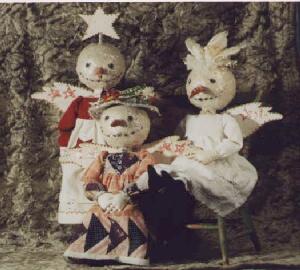
Artist Profile
P A U L G O R D O N
it's no wonder that during his childhood paul gordon enjoyed visiting with his grandmother. she was born in the 1800's and most of the toys and books in her home were from the turn of the century. paul was captivated by her lessons in gardening, sewing, and other practical skills. though she had several granddaughters, it was him that she taught these things. unknowingly his grandmother had planted the seeds of his future career as a doll maker.
after receiving a college degree in painting and print making paul took a position with the west virginia historical society. there he worked in the research department and during his employ trained some 2000 employees to sew period clothing for miniature models. eventually he worked making wedding dresses and evening gowns and restored textiles and clothing.
14 years ago gordon's current business sprouted. a friend admired a prototype bunny paul had used as a model for a baby gift. the friend's encouragement convinced him to make more of these bunnies-and make bunnies he did- for about 3 to 4 years! soon the business shifted from children's toys to collectible santa figures. and that was just the start...santas branched into an expansive variety of creations. today among gordon's wares you might find seasonal creations as well as celestial ones, traditional folk art characters to whimsical with a bit of traditional imagery- even goofy garden figures.
paul says that his 13 room 1830's home is filled to overflowing with found objects -he calls it a "pack rat's paradise". he likes to keep things out in the open rather than packing them up so that his materials are visible and can inspire. his home of 15 years is like a giant palette from which he can create his breathtaking figures. from his stash of buttons, trims, fabric, quilts, clothing and shoes as well as
items he has reclaimed while "junking"- he pulls his inspiration. sometimes from a doodle or idea jotted in his sketch book, other times an idea is built around a quilt or a particular piece of fabric. the variety of creations is quite impressive. when you see the sampling of his work you will notice that much of the material is vintage...mica, quilt batting, fabrics- all of these details are part of what makes his work so wonderfully nostalgic yet unmistakably modern folk art.
in addition to being very adept at sewing paul is also quite a talented sculptor. the faces of his figures are sometimes worked into or onto an actual dried gourd or a found object such as an old alarm clock. at any one time paul might have on hand several completed heads -he says some have been with him for a few years and that he doesn't always know right away what the finished item will be. he finds that this allows him to enjoy the pieces for awhile before they are sold.
a full-time one-man-show, paul does all his production work himself. to him it seems more like play than work and he is having a great time just doing what he wants to do. paul says there's a real balance needing to please people to make a living yet not feeling you need to do what they are "expecting" from you. it's a challenge that he obviously meets quite well. his latest endeavors include working with twin feather sisters (makers of fine feather trees) and a virginia beach couple who do wood carvings to create some combined effort pieces.
Paul Gordon pieces shown are:
- 2 black oil cloth dolls © 1999 - 36"
- snowglobe snowman - 10"
- garden gnome - 40"
- snowbear - 40" (the head comes off of the snowman to reveal a bear)
- snow angel trio - 24"
- bunny on straw hat
PAUL GORDON
burlap sack
SEND $5 FOR A COLOR BROCHURE
122 n. maple ave.
martinsburg west virginia 25401
please mention that you saw this article in the seed pod
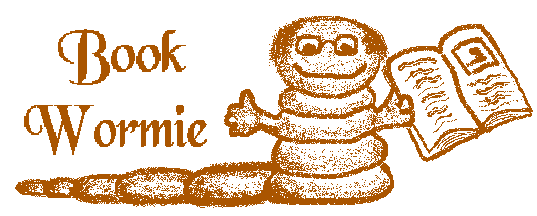
book reviews
&
books of interest
Mary Emmerling's American Country Flags
Clarkson Potter
ISBN: 0517583666
"MUD PIES AND OTHER RECIPES a cook book for dolls"
by MARJORIE WINSLOW
isbn 082774873
china berry books (800) 776-2242
Quilts from the Civil War: Nine Projects, Historic Notes, Diary Entries
by Barbara Brackman
Paperback - 128 pages (November 1997)
C&T Publishing
ISBN: 1571200339
Furnishing the Old-Fashioned Garden: Three Centuries of American Summerhouses, Dovecotes, Pergolas, Privies,Fences & Birdhouses
by May Brawley Hill
Hardcover - 160 pages (October 1998)
ISBN: 0810933357

web sites of interest
some classic folk art toys rendered by various artists,example of schimmel and sunday toys. this link starts you at the adam & eve sunday toy,be sure to check out the other tours on the site.
http://www.nga.gov/collection/gallery/iadpenn/iadpenn-20310.0.html
quilt books
http://ttsw.com/BookStore/Quiltbooks.html
"antiques beat" article on folk art
http://www.antiquesamerica.com/beat/detail.cfm?ArticleNo=549
pots plus
http://www.potsplus.com/
prose
The Little Plant
In the heart of a seed,
Buried deep, so deep!
A dear little plant
Lay fast asleep!
"Wake!" said the sunshine,
"And creep to the light!"
"Wake!" said the voice
Of the raindrops bright.
The little plant heard,
And it rose to see
What the wonderful
Outside world might be.
---Kate Louise Brown
its red for love,
and its white for law,
and its blue for the hope that our forefathers saw,
of larger liberty.
unknown

|
|
All rights reserved. No part of this newsletter may be reproduced without written permission from the publisher, except by a reviewer who may quote brief passages in a review with appropriate credits; nor may any part of this newsletter be reproduced, stored in a retrieval system, or transmitted in any form or by any means -- electronic, mechanical, photo- copying, recording, or other -- without written permission from the publisher.
 HOME PAGE
HOME PAGE